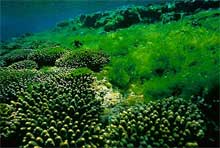Algae could help feed the world

Algae as a base for fuel is becoming less common since subsidies dried up and speculative algae-based biofuel companies are having difficulties staying afloat. It takes too much time and money to find the right algal strains and to really bring algae-based fuels to scale. Algae as a food source have more future, Forbes writes.
South San Francisco-based Solazyme got into green chemistry, producing algae-based versions of palm oil and dielectric fluid (used atop telephone boxes).
Seattle-based Blue Marble Biomaterials has shifted its focus to producing flavourings and fragrances–once byproducts from its algae-to-fuel process and now lucrative products.
Aurora Algae, which just picked up another $22 million in venture funding last year, is perhaps the most diversified of the algae companies, producing everything from nutraceuticals and pharmaceuticals to palm oil and animal feed.
Both Solazyme and Aurora are continuing to work on the production of fuel as well. “We are still working on algal fuels, and have the technology to increase our biofuel output once we have the land and there’s an established market, but in the meantime we are producing and marketing other high-value products,” explains Aurora’s vice president of business development Leslie van der Meulen to Forbes.
More efficient
Comparing algae to soybeans, van der Meulen notes that the former has a year-round harvest and can produce 38 times more usable protein per acre per year than soy, using one percent of the water that crop needs. “Ultimately, we may not need fresh water at all,” he adds.
The resulting protein can be used in myriad food products and also as both animal and fish feed, which could make algae an important input for the aquaculture industry, which is predicted to grow from 80 million to 160 million tonnes of farmed fish in the next 20 years.
“There’s no way there will be enough salmon for people to consume, or that salmon will have the nutrients they have now. Demand is actually already outstripping supply.”
Specific strain
The reason Aurora has been able to diversify its product portfolio so much is largely the particular strain of algae it works with.
Dr. Bertrand Vick, co-founder of the company and its chief scientific officer says when Aurora first started, they spent nine months studying various strains, seeing which grew best, and which best fit the criteria for biofuel–an oil content of 30% or higher, the ability to grow outdoors (Aurora never got into the photobioreactor game, opting instead for open-air ponds), and the ability to produce the right types of oil.
“We found this organism that was not only very suitable for biofuel, but could also be cultivated at a low cost,” Vick says. “Fortunately the cost for producing other high-value products also turned out to be low, which means our profits are pretty good.”
Aurora is breaking ground on a new plant in Australia at the end of this year and will be producing and selling products into various markets next year.
Heliae funding success
In Arizona, Heliae announced a capital rise of $15 million in funding from international conglomerate Salim Group’s agribusiness company, PT PP London Sumatra Indonesia, through its wholly-owned subsidiary, Agri Investments.
This makes a total of close to $50 million in funding that Heliae has received since launching in 2008.
As a start-up venture spun out of Arizona State University with the support of Science Foundation of Arizona, Heliae’s mission is to develop and validate technology solutions for the commercial production of algae for a variety of potential uses including food & feed, fertilizer, chemicals, pharmaceuticals, cosmetics, and fuel.
This new round of investment will support tangible steps toward creating an international presence for Heliae’s technology by funding continued research and development at Heliae’s demonstration facility in Arizona, and taking steps toward operating an R&D centre in Indonesia. The aim is for commercial production in 2014.











